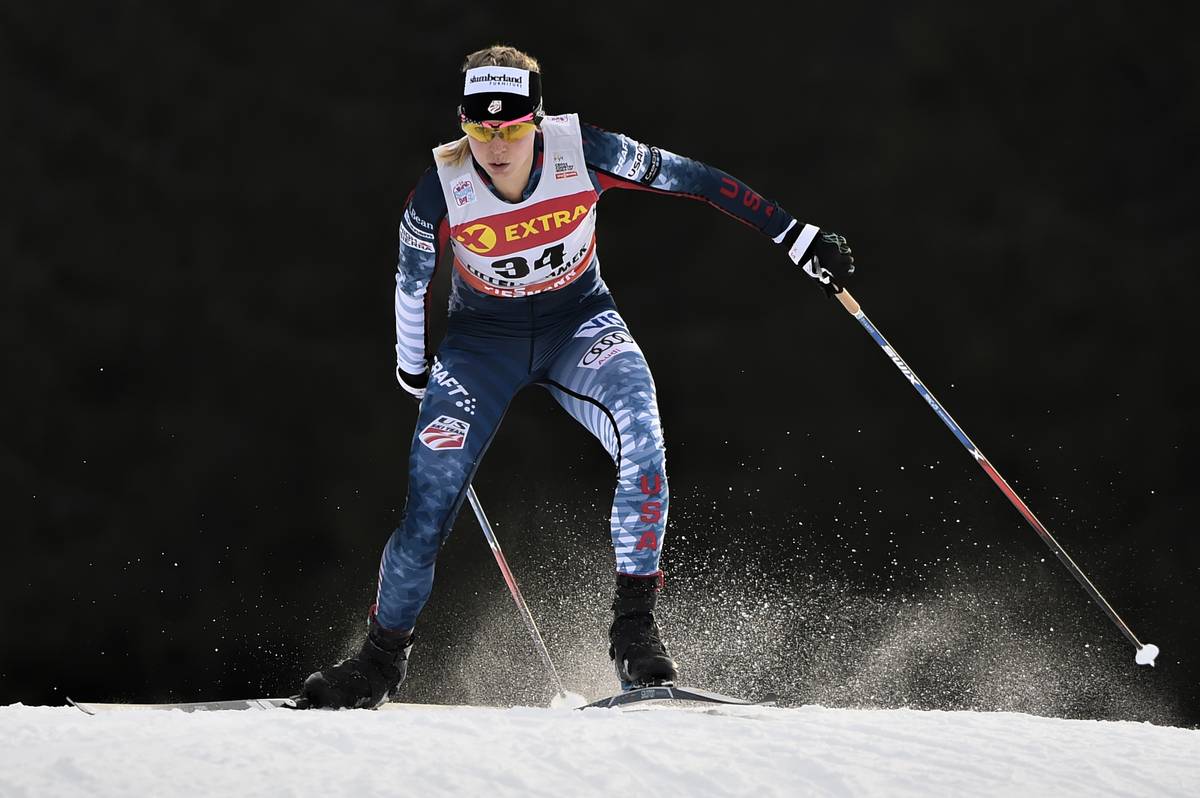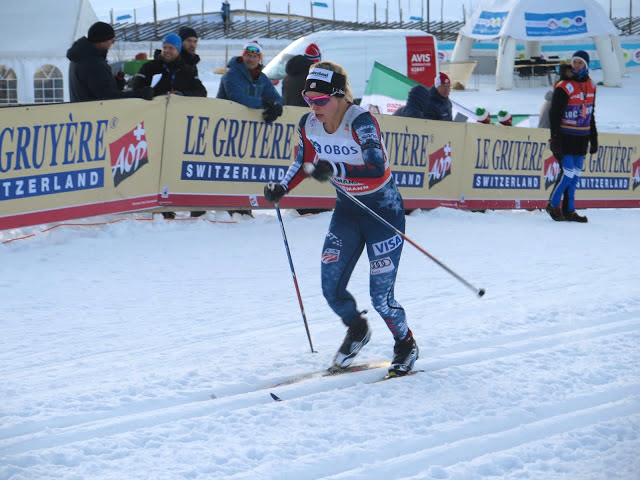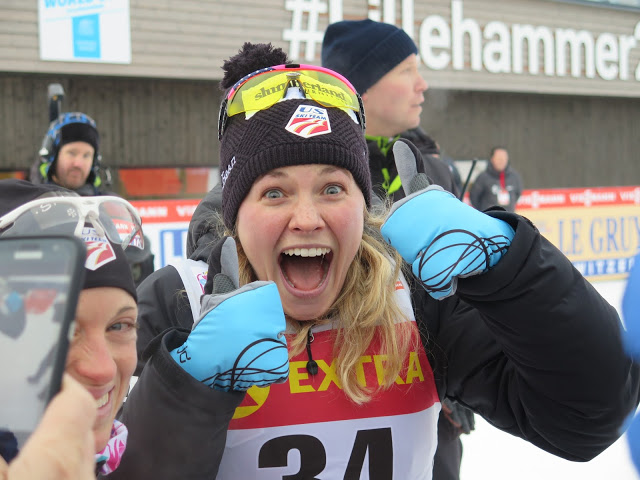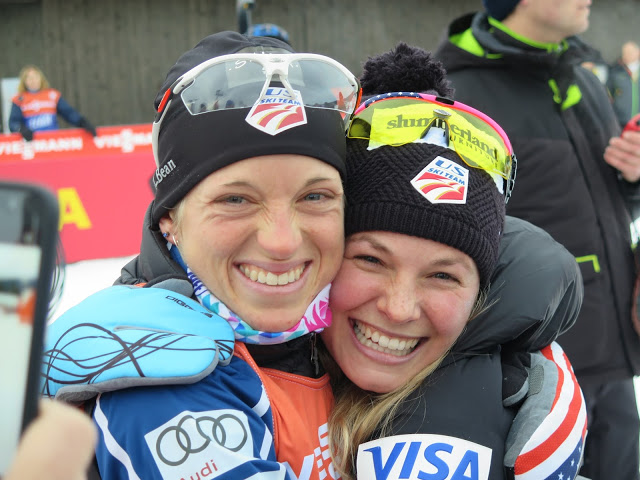
Note: This article has been updated to include American Rosie Brennan’s result.
***
There are several different ways to describe Lillehammer’s 5-kilometer freestyle course, complete with at least five notable climbs, one of which takes a World Cup skier about 3 1/2 minutes to conquer.
“Fun” isn’t the word most would use, but most aren’t Jessie Diggins.
A 25-year-old member of the U.S. Ski Team from Afton, Minn., Diggins rounded the one-lap course with a speed no one else could match in the women’s 5 k freestyle on Saturday. Starting in bib 34, she became the carrot on a string for late starters like Norway’s Heidi Weng (who, after winning Day 1 of the Lillehammer mini tour, had the advantage of picking her starting number first. Weng picked 60th, and Diggins, the 15th-ranked skier with the last pick, was given bib 34).
Diggins attacked the course out of the start, clocking a slightly slower time than the leader at the time at 0.8 k, Astrid Uhrenholdt Jacobsen of Norway. About 2 1/2 seconds down to Jacobsen, Diggins seized control less than a kilometer later at 2.2 k, besting Jacobsen’s time by 2.1 seconds. Jacobsen started 30th.

Over the second half of the course, Diggins increased her lead to 9 seconds over Jacobsen at 3.3 k then bumped her from the leader’s chair at the finish with a time that was 16.4 seconds faster.
But the American’s biggest threats came from behind. Norway’s Marit Bjørgen started 52nd, yet she couldn’t come close to Diggins throughout the course’s three checkpoints. Weng took an early lead at 0.8 k, 0.5 seconds faster than Jacobsen and nearly three seconds ahead of Diggins, but she lost it at 2.2 k.
As Weng motored up the final climb before the stadium, Norwegian fans lining the sidelines screamed to cheer her on. The seconds were ticking away fast and Weng needed to best Diggins’s time to win her second-straight race in as many days.
By the time Weng entered the finishing straight, it became clear — this race was Diggins’s.
Watching Weng finish, surrounded by her coaches and support staff, Diggins put her hand over her mouth and turned as they collectively embraced her. The win was her second in less than a year, and the second of her career. The last time a World Cup 5 k freestyle was held — in Toblach, Italy, last January — Diggins won it. She once again proved herself unbeatable in that format.
With a winning time of 12:40.3, Diggins held off Weng by 4.8 seconds and was 15.8 seconds faster than Bjørgen in third. Jacobsen placed fourth (+16.4), and Norway had four in the top five with Ingvild Flugstad Østberg in fifth (+17.2). The win elevated Diggins from 15th to third in the mini-tour standings with one race (a classic pursuit on Sunday) remaining.
“Normally I work into the season a little more and start pretty slow,” Diggins told a reporter after Saturday’s press conference. “Of course, when you’re training in the offseason, you’re always hoping you’ll have a great season, so I was like, eventually I would love to have another podium, but I didn’t expect it to come so early in the season. But I’ve been waiting and waiting for a skate race and I love the 5 k skate. I had a lot of fun today.”
“I don’t think anybody on our staff or any athletes on the team expected anything less from a challenge for the podium today,” U.S. Ski Team (USST) Women’s Coach Matt Whitcomb said on the phone about Diggins after her win. “Not really maybe an expectation so much it is a belief in Jessie to really engage with the course, really enter that state of flow that we work so hard to define and achieve, and I feel like she was there today.
“She said it was ‘fun’ today and the pain didn’t feel like the normal pain,” he added.
Immediately after the race, Diggins told FasterSkier that belief and support from her team was what fueled her.
“So many people were like, ‘Hey, this is your wheelhouse — go get it,’ ” Diggins reflected.
“When you get to train with such cool people, that belief, that confidence, it opens up opportunities. And I had such a great opportunity,” she said in a televised interview with FIS media director Jeff Ellis (her teammate Kikkan Randall’s husband).

“My coaches and staff work so hard so when they gave me this opportunity I really had to take it,” Diggins continued. “… It means a lot that when everything goes right, you can ski with the best in the world.”
She added she hoped her win would inspire young skiers, especially those she helps coach during the summer in the Midwest.
“Hopefully this will mean a lot back home because I’m not special or different in any way. If I can do it, all the little kids back home, they can do it, too!” Diggins said.
When Ellis congratulated her, telling her she was the best in the world, Diggins giggled.
“Oh geez, thanks!” she said, with a little Midwest twang.
Reflecting on the course, she described it as “super fun,” in an interview with FasterSkier.
“The downhills are like, WOOO! You know? Like, really fast,” Diggins said. “And I am really happy with my skis; all my equipment was great.
“We have such hardworking techs and coaches, and I mean, there’s all these [team] wax trucks out here, and [our wax techs are] working out of a little box, and they’re working so hard,” Diggins later said in another interview.
U.S. head coach Chris Grover reiterated that the team’s entire staff works hard to ensure each athlete has the best day possible.
“We are working out of small containers, but next year at this time we will be working out of a truck so we won’t be able to use that excuse forever,” he said with a laugh. “But these guys have done a really good job on skis so far this year, and … they really know how to work together in a symbiotic way.”

Reflecting on Diggins’s performance, both coaches said what was perhaps most impressive was her achievement from a relatively early start position.
“Jessie’s a great hunter out there, when it’s a relay or a mass-start situation when she can come from behind,” Whitcomb said. “Today with bib number 34 and Heidi 60, on one hand, if you can find the focus that Jessie can, she can be free from those kinds of restraints, but there’s nothing like knowing somebody is three seconds ahead of you, to be able to find that little piece of your brain that will tell your body to close that gap.”
(Last year in Lillehammer, Diggins anchored the U.S. women to third in the 4 x 5 k relay.)
“She just had her head down the whole time, and as we know, she’s got this amazing ability to really ski fast in the closing kilometers of a race,” Grover said. “She really just knows how to push hard in the end. … It was super exciting. We went into the day for sure knowing it could be a big day for Jessie, but to her credit, man, she just put her head down and went out there and did it.”
When it comes to a World Cup 5 k, they’re few and far between. Lucky for Diggins, there is another one coming up in Toblach during the Tour de Ski. Asked how he would describe the format of the 5 k race, Whitcomb said it has a lot to do with headspace.
“It’s a very hard event,” he explained. “You have to be mentally engaged … to bring 13 minutes of pure focus without one second of leaving the course or … to a negative thought about the trance that’s settling around the body. … Today, there’s no hiding out there. In a 5 k, you’re exposed to the clock.”
‘I had a feeling that Jessica would win’
At the finish, Diggins approached Weng and hugged her.
“Before I started, I knew it!” Weng said to Diggins about her win.
Diggins told her she had a great race, and a few minutes later, she was standing on the podium between two of Norway’s best skiers — Weng in second and Bjørgen in third.
“She is incredibly cheerful, which is very contagious,” Weng said at the press conference. “I had a feeling that Jessica would win today, I even told her before the start because she showed great strength here in Lillehammer a year ago during the relay, and when watched the relay we saw that she passed athletes on the downhills and not uphill, so I knew that if I were to beat I had to go fast uphill. I had a few extra seconds on the top, but … I had a feeling that Jessica would clinch the victory and I am happy that she won.”
Bjørgen said at the press conference that the 5 k distance wasn’t too short for her, but she didn’t feeling great early in her race on Saturday.
“I had some girls in front of me so I pushed in the last kilometers and took some seconds on Astrid and could be on the podium, so I’m happy for that today,” she said. “It was not my best race, but it’s a beginning and I am very happy to be on the podium.”
In an interview with NRK, Diggins was asked why she’s good at downhills.
“That’s a good question, I’m actually kind of clumsy, but I’m able to push as hard as I can,” she said. “And I think the course is fun. I look at as a game.”
“She is awesome in the downhills, where she took a lot of seconds,” Bjørgen told NRK. “All I can do is to congratulate.”
Now third in the mini-tour standings, Diggins will start Sunday’s 10 k classic pursuit 21 seconds behind Weng in first, and 1 second behind Østberg in second. Then she’ll have Bjørgen 5 seconds behind her.
“I’m just gonna go out there and have fun,” Diggins said. “I mean, I have Marit Bjørgen starting right behind me … that’s so cool and I really admire her and I hope that when she comes by me I can try to ski as smooth behind her as possible for as long as I can.”

The second U.S. woman in the top 15 on Saturday (and the fastest woman in the world in Friday’s sprint prologue), Sadie Bjornsen finished 14th (41.8 seconds behind Diggins) on a course she said didn’t necessarily suit her strengths. That elevated her to 12th in the mini tour, 1:02 minutes behind Weng and within 5 seconds of the top 10.
“If I envisioned myself having the perfect skate course it would be something more similar to Toblach, and maybe not a course like this,” Bjornsen said on the phone after. “But today, maybe I learned you can do it here, too.”
Last January in Toblach, Bjornsen placed 13th in the 5 k freestyle Diggins won.
On Saturday, she started 36th, a minute behind Diggins, and crossed the finish line in seventh.
“Jessie started like one minute in front of me and I was making some jokes at the beginning that I should just keep my eye on her and follow her, but turns out I couldn’t even catch her in my eye today,” Bjornsen said with a laugh.
Not entirely sure how her race was going while pushing through the pain of the 5 k, which included a 750-meter-long climb in the middle, Bjornsen heard someone say she was fighting for a top 10.
“You have to keep telling yourself that every single second counts, so I was sort of staying in my head,” she reflected.
Over the first half of the course, Bjornsen tried to “send it”, but sensed some early fatigue in her legs.
“I think that I panicked a bit so I struggled a bit in the middle 2 k, but then as soon as I was halfway up that hill, I was like, wait a minute, this is what we do for training, like this is not outrageous. I do five-minute interval repeats up a hill all the time, so this is totally my territory,” she said. “I really started getting into the grove for the second half of the hill.
“You almost fear hills when you hit the World Cup course, well, for me anyway, because they have never been a huge strength of mine,” she added. “I am slowly discovering that I have to start really looking forward to the hills and not having any sort of fear. The best racers, that’s what Jessie went out there and did today, just had no fear. I’m getting there each time that I race … so it was kind of a fun race for me today because it was confidence building in one way and a learning lesson. Early season is really nice for that.”
“Two years ago, she would’ve said no way is a [14th] happening in a 5 k skate that has a three-and-a-half-minute climb in it, but she’s just erased that obstacle,” Whitcomb said of Bjornsen. “This is now a course Sadie can compete on. She can be the beast of all courses.”

Three U.S. women finished in the points, with Liz Stephen in 26th (+51.2).
“For Liz, having her first distance start of the season, she looked awesome on the climb and skied the downhills aggressively,” Whitcomb said. “Add 5 k to that in another week or two and I think we’re gonna really like where we see Liz.”
“I think I paced it well, and it’s nice to just get your feet under you a little bit as the race season gets going,” Stephen said in an in-person interview. “I think I skied the technical sections of this course better than I have in the past so I feel really good about the day.
“… Today I was just really happy to be here racing, and the things that are difficult kind of just fade away when you’re going through your race,” she said. “I found today just really fun, honestly.”
The team’s Continental Cup leader Caitlin Patterson finished 7.3 seconds outside the top 30 in 38th (+1:01.3), Rosie Brennan placed 48th (+1:12.8), Sophie Caldwell was 59th (+1:30.4), and Ida Sargent 67th (+1:45.5).
Asked in person what she felt worked well in Saturday’s race, Patterson said she was pleased with her transitions.
“Any time I felt like I was getting bogged down on the hill — there were a lot of cheers for the U.S. out there, the coaches and some other fans were out there — so any time I heard that, I tried to use their voices to motivate and pick up my tempo and keep pushing,” she said.
“I think it was a pretty good effort, but there were just some moments out there when I felt like I could have done better,” Patterson explained. “… I tried to re-focus myself to thinking of the future, the future corners and hills that I could do better, so I think it was pretty solid. Definitely, I would say I felt just a touch left from perfect energy, just a little bit heavy legs, but overall pretty good.”
Canada was led by national U25 Team member Cendrine Browne in 50th (+1:18.5). Emily Nishikawa (World Cup B-team) placed 52nd (+1:19.1), and Dahria Beatty was 62d (+1:34.4).
Overall, Whitcomb said the U.S. team feels good about where they’re at in the second weekend of the season.
“With the plan that we made, we fully took ownership that the results could be disappointing with athletes and fans for the first part of Period 1, but I think we found that was, in fact, the case,” he said. “We just didn’t have our skiing legs right under us, we weren’t quite recovered, hadn’t raced enough. … But with that comes does a pretty quick curve of improvement.
“The general vibe on the women’s team right now is one of getting better,” he continued. “So I think everyone feels really good about the strategy, has patience with where they are yet, if they’re not happy with where they are yet, and believe the plan will work for them.”
Results | Mini-tour standings (after Day 2) | Pursuit start list
Alex Kochon
Alex Kochon (alexkochon@gmail.com) is a former FasterSkier editor and roving reporter who never really lost touch with the nordic scene. A freelance writer, editor, and outdoor-loving mom of two, she lives in northeastern New York and enjoys adventuring in the Adirondacks. She shares her passion for sports and recreation as the co-founder of "Ride On! Mountain Bike Trail Guide" and a sales and content contributor at Curated.com. When she's not skiing or chasing her kids around, Alex assists authors as a production and marketing coordinator for iPub Global Connection.



